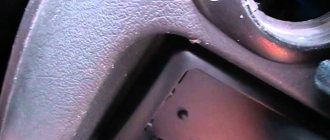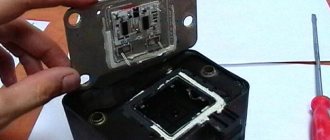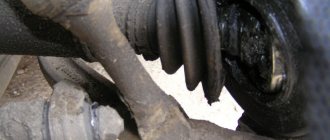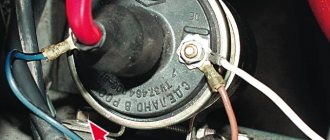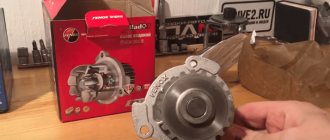Signs of a malfunctioning ignition module
The list is relevant only if the other systems (spark plugs, injectors, crankshaft position sensor, cylinder compression, fuel system) are in good working order and operate according to the established parameters. The symptom of a faulty spark plug may not differ from a banal loss of contact between the ignition module and the high-voltage cable.
- Troubles the engine. In fact, there are many reasons, but the main culprit is our module. Moreover, this could be a contact phenomenon, or a breakdown of the radio element. A clear sign of coil failure is that failures occur in two cylinders simultaneously. That is, candles either Nos. 1 and 4 or Nos. 2 and 3 “do not burn.”
- The engine thrust has noticeably decreased. The car does not hesitate, it runs smoothly, but acceleration uphill or under load occurs lazily.
- During sharp acceleration, a kind of failure of thrust occurs in the engine. It's as if the fuel pump is not performing enough. If the gas tank is in order, look for the cause in the ignition module.
- At idle the speed fluctuates (of course, with the IAC running).
And of course, the “check engine” alarm. If the fault is detected by the ECU module, this is good for diagnosis. You can read OBD errors in any available way:
- using electronic odometer codes (if such an option is available);
- using the on-board computer, if it has a decoding function;
- any diagnostic scanner, for example, ELM327 paired with a smartphone.
If you recognize error codes associated with misfires specifically in a pair of spark plugs, the most likely cause is a faulty ignition module.
Possible reasons for failure of the ignition module
Before repairing the main part in the car’s ignition system, you need to understand the nature of the problem. To do this, the consumer must be aware of the signs of a malfunction, as well as the causes of the breakdown.
The main reasons for device failure
Causes of problems:
- The ignition system uses spark plugs that do not match the vehicle parameters. They may not have the gap specified by the manufacturer. Also, the spark plugs themselves may not be working or dirty; this can be determined by visual diagnostics. If there are traces of carbon deposits on the devices, they must be removed.
- Malfunctions in the operation of the MH can arise as a result of frequent spark checks. At the time of diagnosis, a high load is placed on the device. If it appears frequently, it will lead to equipment failure or incorrect operation.
- The ignition module in the VAZ 2114 operates with the high-voltage cables disconnected. This also leads to device failure. The products themselves may be damaged, which affects the functioning of the engine as a whole.
- The device operates under severe vibration conditions. Their impact may be due to poor quality fixation of the module in the seat. As a result of vibrations, the factory soldering inside the equipment structure is damaged. This leads to its incorrect operation.
- The contact inside the plug with the low-voltage cables is broken.
- Initial use of a defective device or module with poor build quality. This factory defect can only be eliminated by replacing the mechanism; repairing the equipment is pointless.
- Moisture getting inside the case. This problem is unlikely, but exposure of the device to liquid may cause it to short out and break.
Signs of coil malfunction
The main symptoms of a malfunction in the VAZ 2114 ignition module:
- Difficulties arise when trying to start the engine. Starting the car engine may be difficult due to the fact that there is no spark on a spark plug or several.
- When idling or parking with the internal combustion engine running, the speed of the power unit floats. Their change is not associated with pressing the gas pedal and other third-party factors. This happens randomly.
- There are dips in the power of the car's engine. This is especially felt when driving uphill or sharp acceleration. Problems can also occur when driving on a flat road.
- Several cylinders stopped working. Usually these devices operate in pairs, so elements 1-4 or 2-3 could fail. Non-working cylinders may be indicated by “triple movement” of the engine.
- A “Check Engine” warning light appeared on the dashboard.
If the ignition module malfunctions, problems will appear not only in engine operation, but also when starting it.
The “Simple Opinion” channel, using the Lada Priora car as an example, spoke in detail about the symptoms that appear in the operation of the ignition modules.
System diagnostics
If signs of damage are detected, there is no need to immediately remove and repair the MH. First, the spark plugs must be checked; to do this, they are removed from their sockets, and the high-voltage wires are first disconnected from the spark plugs. The spark plugs should be carefully inspected, cleaned of carbon and deposits, and then checked again.
Brown color is acceptable on these devices, but soot and carbon deposits are undesirable. If necessary, you also need to adjust the gap between the element itself and the electrodes. More detailed instructions for diagnosing the module yourself are given in the video below (the author of the video is Alexey Romanov).
How to quickly check the performance of the coil at home:
- Of course, the fastest and easiest way would be to install a unit that is known to work, but it is unlikely that anyone will carry a working spare device with them.
- While the engine is running, try tapping the coil. If you notice changes in the operation of the motor, this indicates that there is poor contact inside the device.
- The most accurate results can be obtained from diagnostics with a multimeter. You need to measure the resistance of the paired terminals of the coils, in particular the first and fourth, as well as the second and third. The parameter should be 5.4 kOhm; if the values differ, the device needs to be repaired or replaced.
Useful video
You can find interesting information by watching the additional video below: https://www.youtube.com/watch?v=pNyBny-_HoQ
On a car with contactless ignition, everything is even easier; you don’t have to remove the wheels, but you will need an assistant. It is necessary to find the compression stroke of the fourth cylinder. To do this, insert a rubber cone into the spark plug hole and turn the ratchet. Pushing out the cone will mean that the compression stroke has been found.
Having illuminated the spark plug hole, we align the longest mark of the cover with the mark of the pulley. We set the breaker to the appropriate clock and check the operation of the system according to the fourth point described above.
Module replacement
Replacement is carried out using a hexagon, a 10' head and 13' and 17' keys.
- You need to disconnect the negative terminal from the battery.
- Then remove the wiring harness.
- Pull out the signed high voltages.
- Remove all fastenings to the motor.
- After these steps, the faulty element will be exposed to the motorist. You can get it out using a hexagon.
Replacing with a new unit begins with connecting high-voltage wires. There should be hints on the case, but you can use your own. The wires should also be carefully examined - they should have marks that indicate the cylinder number. For example, if the number “2” is on the wire, then it is intended for the second cylinder. Replacement is complete. Now you need to start the VAZ 2114 engine and check whether the module is secured correctly. If necessary, tighten the fasteners.
Location of the VAZ 2114 module under the hood
Before going to a car dealership to buy a new module, it is recommended to check the device contacts. If they fail, you can do the repairs yourself and not spend money on a new module. To check, you need to start the engine at idle and try to press the module cover with an insulated tool. If the engine starts working normally, then the problem is in the contacts. The work is not difficult, but quite painstaking, and you will need skill in handling a soldering iron. For repairs, you need to stock up on small and thin wires, varnish, a soldering iron, a screwdriver and flux for soldering aluminum.
- You need to dismantle the device according to the instructions described above.
- Next, you need to remove the housing cover; to do this, press down with a screwdriver. If the device is not standard, there may be bolts there.
- On the board you can see whether the guesses are correct or not.
- If the contacts have come loose, then you need to strip the board of small wires and replace them with new ones.
- A problem may arise with transistor controllers - they are covered with a protective layer that the soldering iron does not take. It can be cleaned with improvised materials or a burr machine.
- Small wires need to be replaced.
- The final step is to cover the soldering areas with varnish or silicone. Even nail polish will do. That's all.
How to check input wires for serviceability
Following the recommendations of specialists, to check the condition of the wires at the input, they need to be “ringed”. What does it mean?
- Determine the operating format of the multitester in the voltmeter position, and then disconnect the wiring block from the VAZ-2114 ignition module.
- Focusing on contact A, mount the first dipstick, and fix the second one to the engine ground.
- Ask an assistant to start the car or, alternatively, crank the starter. At this time, your task is to observe the measurements on the display. Normal voltage is 12 volts.
- Carry out exactly the same actions with the remaining contact.
What to do if there is practically no voltage? Then evaluate the serviceability of the fuse - it is likely that it has blown. Find 3 safety mechanisms on the VAZ-2114 electronic control panel. So, the third 7.5 A is a device suitable for the car module.
Even if the fuse is intact and intact, there is a possibility of oxidation and wire breakage, as well as loose contacts.
What to do if there is no multitester available? A control light designed for 12 V will help solve the problem. One wiring of the lighting device is placed to the contact of the block, and the other is closed to the motor housing. After turning on the ignition, the light should flicker.
How to check the VAZ-2114 ignition module with your own hands is shown in the video instructions:
Signs of breakdown
Disassembled
In fact, the symptoms of a malfunction in the VAZ 2114 ignition module are in many ways similar to the breakdown of other units. For example, you may observe the following phenomena:
- The engine is tripping;
- The car stalls at idle;
- There are problems when trying to start the car, etc.
That is, in fact, it may not be a module at all. Therefore, the only correct solution is to check the ignition module on your VAZ 2114.
It is a mistake to assume that damage to high-voltage wires does not in any way affect the condition of the module itself. Many people think of simply replacing high-voltage elements, but in reality they will still have to change the module.
This is explained by the fact that damaged or defective wires direct the wrong current, the configuration of which does not correspond to the necessary parameters. As a result, the spark hits inaccurately or ineffectively, causing the module to burn out and become unusable.
In general, the best option for checking the ignition module on a VAZ 2114 is to use an oscilloscope. But, firstly, not every driver has it, and secondly, few people can use them. Therefore, we will carry out the check using improvised means:
- 12-volt light bulb;
- Tester (available for little money at any auto parts store).
Let's start with preliminary manipulations with the accompanying elements of the ignition module.
- Check the wiring harness. It is disconnected and the voltage indicator is checked.
- To do this, fix the tester on contact A, and connect the other terminal to engine ground.
- In normal condition, the voltage reading will be 12V.
- If there is no voltage, most likely the fuse has blown.
- If everything is fine, transfer the terminals of your tester to contacts A and B, start the car. In this case, the starter should turn and the 12-volt light should blink.
- In the absence of these phenomena, we can talk about the presence of a break in circuit A of the contacts.
Next we go to the ignition module itself.
There are several ways to check the condition of your unit. Therefore, let's look at each of them.
- Set the tester to ohmmeter mode. Use it to measure the resistance on the high-voltage lines going to cylinders 1 and 4, and then, by analogy, to the wiring of cylinders 2 and 3. In normal condition, the device will give you readings from 5.2 to 5.5 ohms.
- Give the device a gentle tug. Thus, you will shake the wiring block and the module. Moreover, this must be done in the operating mode of the power unit. If the device works without obstruction when loosened, everything is fine, you are lucky. If not, you will again have to study the condition of the wiring.
Third way
The third method is considered the simplest, since it involves replacing your device with a similar one that works exactly. But to do this, you have to find a full-fledged twin. We are talking about an ignition module from a car similar to yours in terms of year of manufacture and power unit used. It’s just that 1.5-liter engines have modules, and 1.6-liter engines have coils.
But to replace a module with a module, you will have to first dismantle yours. This is done as follows:
- Remove the negative terminal from the battery, which will allow you to turn off the power to the car;
- Disconnect four high voltages from the ignition module;
- Disconnect the wire block. To do this, you need to release the special clamp that holds the block on the module;
- Next, unscrew the three nuts. With their help, the module is held on the bracket;
- There are three long pins on the bracket, from which the module can simply be pulled off.
Having dismantled your module, you can put another unit in its place, thereby verifying the functionality of that one and the malfunction of yours.
Checking the ignition module with a multitester
You can buy a multimeter at any auto store. It is inexpensive and useful for checking all electrical elements of the car. Even if you have no experience in such work, you can follow simple instructions and easily carry out diagnostics in the garage or right in the yard:
- To check the ignition module itself, you need to check the contacts going to the high-voltage wires. To do this, you need to set the device to ohmmeter mode and measure the readings. First do this on cylinders 1 and 4, and then on cylinders 2 and 3. If everything is in order, the resistance readings at each of the terminals will be in the range from 5.2 to 5.5 kOhm. If the difference exceeds 100 ohms, we can confidently say that the problem lies in the secondary winding.
- You should also check the contacts without using any devices. To do this, the engine starts, then you need to open the hood and slightly pull the body in different directions. When there are no changes in operation, everything is in order: if interruptions occur, you need to check the connections. If this does not help, most likely the reason is in the module itself. It cannot be repaired; the easiest way is to replace it.
Another option for checking functionality is to replace the unit with another from a machine in which everything works well. When friends have a car with the same ignition module, you can remove it and install it yourself, and then check the operation. If everything is normal, then you don’t have to look for reasons further.
In case of malfunctions, replacing the part will not be difficult on your own. To do this you will need a simple set of tools and following simple recommendations:
Disconnect the negative terminal of the battery. You cannot work with the battery connected! Carefully disconnect the block with wires. There is a lock on the connector that you need to press out, and then, by shaking, pull off the chip. If it has never been removed, it may take considerable effort to get it out of place, but then everything will be quite easy. Carefully disconnect the high-voltage wires from the connectors. The main thing is to remember the order in which they are located so as not to get confused. You can stick pieces of paper tape and put down numbers. If the condition of the wires raises questions or they were replaced a long time ago, it is advisable to buy a new set and install it. The body is mounted on three studs. You need to unscrew the nuts that secure the assembly. Then gently pull it up. The new module must be installed in place and the nuts must be tightened without applying excessive force so as not to damage the plastic. Install high-voltage wires. To be sure, you can check the marking: it should be on the new MH
It is important to insert the end switches well into the connection so that they go all the way in and the rubber seal is pressed against the body.
After finishing the work, reconnect the battery terminal. Start the engine and make sure everything is in order. If the problem does not go away after checking the wiring and replacing the unit, you need to look for the problem among the sensors, diagnostics will help here, since it is impossible to determine the fault by eye.
Malfunctions of the VAZ 2114 ignition module
Determining that a module has malfunctions is not so difficult. One of the signs is a decrease in engine power of the VAZ 2114 or acceleration in jerks. If the unit malfunctions, the engine begins to operate intermittently when idling. If such “symptoms” are present, then it is necessary to check the serviceability of the spark plugs and the fastening of high-voltage wires, as malfunctions may appear due to these elements.
Checking the VAZ 2114 for malfunctions must be carried out in compliance with safety precautions: hands must be wearing rubber gloves, and tools must be isolated. If the spark plugs and wires are in perfect order, the module needs to be replaced. You can find it under the hood; the device will reveal itself as large high-voltage circuits, from which replacement begins.
The module is quite easy to get, as there are minimal fastenings on it
In order not to make a mistake with connecting the wires when replacing, it is advisable to plug the high-voltage wires into their sockets and then label each of them. Then the new ignition coil can be connected, following the wires from the old one. Modern units have numbering that will help you figure out the connection. Marking will be useful if you buy an old-style module without numbering on the outputs.
Explanation of the ignition coil designation (Catalogue number) - 2111-3705010;
The designation of a part or assembly is a unique number in a single form. Assigned to only one part. The numbering of designations for assembly units and parts is carried out according to a unified seven-digit system. Designation - 2111-3705010-02 is deciphered as follows. The first four digits before the dash indicate the model of the base car or engine, chassis, body. In our case: 2111 is the engine model. The first two digits after the dash indicate the group number, in this case 37 - electrical equipment. The next two digits are the subgroup number. In our case, 05 is the ignition coil. The last three digits of the seven-digit number indicate the serial number of the part. The last two digits after the second dash indicate the interchangeability of the part. ХХХХ-ХХХХХХ-00 (to-09) - interchangeable. ХХХХ-ХХХХХХХ-10 (up to 19) are interchangeable with each other but not interchangeable with ХХХХ-ХХХХХХХ-00 (up to-09) and so on.
How to check the ignition coil: diagnostics and symptoms of failure
The easiest way to do this, of course, is not with your own hands, but with someone else’s hands at the service. But we still need to get there. If the car completely refuses to start, then, among other reasons, the ignition coil may be to blame. If the driver has an error scanner or a diagnostic adapter for diagnostics with data transmission using Bluetooth technology, great.
Here are the main error codes that indicate malfunctions in the ignition system of the eight-valve injection VAZ-2114:
- P3000-3004 - no spark in the cylinder (extreme number), these codes will not say anything specific, but will hint where to look for the cause;
- P0351 is a typical error indicating a break in the module on the windings of the first and fourth cylinders;
- P0352 - the same break, but on the windings of the other two cylinders, the second and third.
This is all that a scanner, module or special application can say. Not every one of these codes indicates that it is time to throw away the coil; sometimes the reason may not be so much in the coil as in high-voltage wires or spark plugs.
Breakdown on the spark plug insulator
Price of the VAZ-2114 ignition coil and its replacement
The simplest thing is to replace the coil. Even a schoolboy can handle this. For the second Samara you need to buy a new ignition module 43 3705. The same coil is used on dozens, on Priors and on 1118 with injection eight-valve engines.
In this case, the electronic control system will most likely have the M7-9-7 index. The price of a new reel is around 1,200 rubles.
The coil is removed and installed in this order:
- Disconnect the negative terminal of the battery or use the ground disconnect button, if installed.
- Remove the caps with tips from the candles.
- Disconnect the low voltage control circuit. To do this, bend the fixing bracket, after which you can remove the block with contacts.
- We remove the high-voltage wires from the coil and at the same time check their condition visually.
- Unscrew the bolts securing the module body itself. There should be three of them.
- Remove the module and bracket assembly from the engine.
- We dismantle the bracket with a hex key.
- We install the new ignition coil in the reverse order, without mixing up the high-voltage wires.
The new module is installed. Nevertheless, we will check the old module as a precaution. There are several ways to do this.
DIY testing methods (requires a multimeter)
Replaced? That is great. Now, before throwing the old ignition coil into the dustbin of history, let’s check its functionality. If after replacement the engine began to work like a clock, then the problem was really in the coil. Although, there may be nuances.
Here are three more ways to make sure that the old coil was not working correctly:
- We measure the resistance between paired contacts on the secondary winding. We take a multimeter, set it to ohmmeter mode and install probes to the terminal to fix the high-voltage wires of the first and fourth cylinders. The display should show a value within 5.5 kOhm. After this, we do the same with the terminals for the wires of the second and third cylinders. The resistance value should be the same. The minimum error cannot exceed one hundred ohms.
- Actually, we can’t do anything else with the coil itself. We check the contacts of the low-voltage control circuit. We install one probe on the engine ground, the second on one of the contacts of the terminal block. When the ignition is on, there should be a standard 12 volts. We repeat the same story with the second contact.
- If there is no voltage at the contacts, either broken wires or a blown fuse may be to blame. It's easier to check the fuse. It is located in the cabin on the center console on the side, on the passenger side. The coil fuse will be the lowest, third, with a rating of 7.5 A. If it is intact, but voltage does not appear on the contact group, apparently, you will have to look for a broken wire.
The principle of operation of the ignition coil
As mentioned above, the ignition coil is a step-up voltage transformer that converts the resulting 12 V voltage into a voltage of several kilovolts. Structurally, the coil consists of two windings - primary and secondary (low and high voltage, respectively). However, depending on the type of coil, the windings and their arrangement differ.
Let's start the description with the simplest common coil. Here there are 100...150 turns on the primary winding. The winding is wound with insulated copper wire. Its ends are brought out onto the coil body. The number of turns of the high voltage winding is 30...50 thousand (depending on the model). Naturally, the wire used here is of a much smaller diameter. The “minus” of the secondary winding is connected to the “minus” of the primary. And the “plus” is connected to the terminal on the cover. This ensures that the resulting high voltage is removed.
To increase the magnetic field, the windings are wound around a metal core. In some cases, to avoid overheating, the windings and core are filled with transformer oil (it not only cools the system, but also acts as an insulator).
Now let's move on to considering the individual ignition coil. There are also two windings here, but the difference is in their location. In particular, they are wound in reverse order. The primary winding has an internal type core, and the secondary winding has an external type.
Individual ignition coils are installed in systems with electronic ignition. Therefore, their design is complicated. So, to cut off significant current, a diode is provided in the secondary winding. Another feature of the individual coil is the fact that the resulting high voltage does not go to the distributor (as in classical systems), but directly to the spark plugs. This was made possible by a design that included an insulated body, rod and spring.
Another type of coil is a two-terminal coil. It supplies voltage to two cylinders at once. There are several varieties of them. As a rule, such coils are combined into one common unit, which is essentially a four-terminal ignition coil.
Regardless of the type of ignition coil, its main technical parameter that you should focus on when diagnosing is the resistance of the windings. In particular, the resistance of the primary winding is usually in the range of 0.5...3.5 Ohms, and the secondary - 6...15 kOhms (these values may differ for different coils, so it is better to find reference information specifically for the model that is used in your car ). Measurements are made using traditional instruments - multimeters or ohmmeters. If the obtained value differs greatly from the specified value, then there is a high probability that the coil has failed.
You also need to be aware that each coil has different indicators:
- winding resistance;
- spark duration;
- spark energy;
- spark current;
- inductance of the primary winding.
Therefore, in order to understand how well the coil readings correspond to the norm, it is necessary to clarify the technical characteristics of your individual coil. This will be especially useful if the spark is lost, since the ignition coil is one of the first elements of the system to be checked.
How to check the malfunction of the VAZ 2114 ignition module on your own?
In order to start checking, you will need a measuring device - a tester. Before starting the measurement, the wire blocks are removed from the connectors. Each block has its own slot (A, B, C, D).
Checking the VAZ 2114 ignition module with a multimeter:
- turn on the car engine;
- set the multimeter switch to measure direct current up to tens of volts;
- one of the probes of the device is connected to connector D, the second to ground. If there is power, the screen will show 12 volts;
- switch the multimeter to ohmmeter mode up to tens of ohms;
- one probe is connected to connector C, the other to ground. If everything is in order, the device will show less than 1 Ohm;
- switch the multimeter to voltmeter mode up to tens of volts;
- one probe is connected to connector B, the other to ground. If a voltage of at least 0.3 Volts is displayed, then everything is fine (a clear pulse comes from the Hall sensor);
- The last measurement with connector A is carried out exactly as in the previous case.
Checking the ignition unit with a multimeter
Another testing method is to directly check the secondary coils for breakdown.
It is performed according to the following scheme:
- all wires are removed from the connectors;
- the multimeter is set to ohmmeter mode up to tens of kOhms;
- the probes are alternately installed in paired connectors (1 and 4, 2 and 3);
- if the windings are in good condition, both measurement results will be the same (on average, they should be equal to 5.4 kOhm). If the resistance turns out to be much higher, then there is an internal break in the turns; if it is much lower, there is a breakdown.
Checking high voltage wires
Also, there is another, easiest way to check the ignition coil of a VAZ 2114 - simply replace it with a new one, completely similar. If after replacement the car began to work properly, then the reason was definitely in the module.
Checking for errors
Checking the ignition device for malfunctions always concerns the location of the wires on the ignition module of the VAZ 2114. For simple diagnostics, we simply measure the resistance between the wires of the first and fourth cylinders and the second and third cylinders with a multimeter. If the indicator is 5.5 kOhm (switch the multimeter to ohmmeter mode!), then everything is in order. There are also other checks:
- The first thing to check is the wiring block; it is better to disconnect it and check it with a multimeter in voltmeter mode: we attach the multimeter probe to pin A, and throw the other one onto the ground of the sliders. We start and look at the voltmeter values: excellent. If the voltage fluctuates around 12 V. If there is no voltage, check the ignition coil fuse, it may blow, as well as the correct connection of all contacts. By the way, about that. Another way of checking can indicate that the circuit of contacts is closed incorrectly: by connecting a tester to both contacts - A and B - connect a multimeter to it; if it blinks, then the circuit is in perfect order.
- It’s worth checking all the high-voltage elements (with the same multimeter in ohmmeter mode); if they are installed incorrectly, the ignition coil will burn out.
- To understand whether the ignition module behaves correctly, move the wire block, you can knock on it. The contact should not disappear, if the engine responds to your movements, the contact is unclear. It can break at any moment.
Symptoms of an ignition coil malfunction are often displayed by the system during basic diagnostics in a service center (or in a garage environment via a connected laptop with a special program) in the form of errors:
- P0351 – break in the winding of wires of cylinders 1-4
- P0352 – break in the wire winding of cylinders 2-3
- P3000 (P3001 P3002 P3003 P3004) – the ignition does not work.
All these errors are motivation for a deeper diagnosis of the situation, on which the decision will depend: replace the module with a new one, or repair it. Also, these errors may indicate a possible malfunction of one of the spark plugs or an explosive contact.
How to diagnose the ignition coil on a VAZ-2114
As already mentioned, when the first signs of malfunctions appear in the VAZ-2114 ignition module, the vehicle owner should diagnose it. You can perform a similar procedure yourself at home using the following algorithm:
- Check the spark plugs.
- Check the crankshaft position sensor.
- Check the ignition coil.
At home, all stages of the checks can be performed independently. The first stage is checking the spark plugs. It is carried out in the following sequence:
- We remove the spark plugs from their sockets - remove the tips of the high-voltage wires (a special spark plug wrench is suitable for this).
- We examine the candles.
- We clean them from possible soot.
- We set the correct distance between the electrodes.
- We check the spark plugs for operation using improvised means (for example, from a device made from a piezo lighter) or on a car engine with a working ignition system.
If the spark plugs are in good condition, you can proceed to the next stage of checking for faults in the ignition module.
The second step is to check the crankshaft sensor. This test is carried out using a multimeter, thanks to which two characteristics are checked - voltage and resistance. To do this proceed as follows:
- Remove the crankshaft sensor.
- Measure resistance:
- a special ohmmeter mode is installed on the device;
- the terminals of the device are connected to the ends of the winding, which is brought to the surface;
- with optimal sensor operation, digital readings will range from 500 Ohms to 700 Ohms.
- Measure voltage:
- switch the device to the mode for measuring alternating voltage;
- terminals are connected to the ends of the winding;
- any handy object made of metal should be passed along the body of the crankshaft sensor;
- When the sensor operates optimally, the device will show increased voltage readings because there will be a metal object nearby.
Otherwise, the faulty sensor will have to be replaced with a new one, because it also affects the operation of the VAZ-2114 ignition module. If after this there are still signs of coil malfunction, then you should proceed to the third stage of the test.
The third stage is checking the ignition coil itself. This part is checked as follows:
- The easiest way is to replace the coil with a new one;
- while the car engine is running, you can move the coil and knock on it (if there are visible changes in the functioning, it is time to judge a faulty contact in the coil itself);
- take measurements with a multimeter for resistance readings, such indicators are taken from paired coils - they should be identical, approximately equal to 5.4 kOhm.
What to do if you don’t have a multimeter, but you need to check the electrical circuit? Experts recommend using a twelve-volt light bulb. To do this, one of the wires coming from it should be connected to the terminal, and the second wire should be shorted to the motor housing. If the control light flickers when the starter starts, then everything is in working order.
If the car owner has problems performing such diagnostics himself, he can always turn to qualified specialists at a service station.
How to choose an ignition module?
On a VAZ 2114 car (8 valves), it is recommended to install an original part with a catalog number 2112-3705010.
The market value of such a module ranges from 2800 to 4000 rubles. However, some car owners select non-original spare parts from another manufacturer for their car. This may be fraught with consequences for the further operation of the vehicle, since the presented analogues may be of poor quality.
Connection diagram
Mechanism connection diagram
You can find the module itself using high-voltage cables - from the spark plugs they go straight to it. The diagram given in this article will allow you to easily replace the mechanism. The device connection procedure can be carried out using one of two methods. When the short circuit is dismantled and when it is located at the installation site in the engine compartment of the vehicle.
If the module is in front of you:
- Contacts numbered 1 and 4 go to one winding, as for contacts 2 and 3 - they are connected to another winding.
- After this, the leftmost high-voltage cable is connected to cylinder 1 (the bottom one in the diagram).
- Another high-voltage wire is connected to the second cylinder, only this time it’s the top one.
- The right high-voltage wire (top) goes to cylinder 3.
- Accordingly, the lower high-voltage cable must be connected to the last, fourth cylinder.
If the assembly is connected to a motor, then the pinout of high-voltage cables will be more complicated, since the mechanism itself is installed at an angle:
- The central lower wire is connected to the first cylinder.
- To the second - left.
- The third contact is connected to the top contact.
- And to the last, fourth cylinder - the right one.
Of course, the first installation method will be simpler, especially if you consider that high-voltage cables must be connected very carefully and carefully. If you accidentally confuse, this may lead to the inability to start the power unit, which is more sad - to the occurrence of malfunctions
As for directly purchasing a new short circuit, this pleasure in general is not cheap. Today, the cost of a node varies from 700 to 1000 or more rubles, much depends on the region of residence. So before changing the node, you can try to restore its functionality:
System replacement
If repairs fail to restore the device’s functionality, you will need to replace the module with a new one. At the same stage, you can move the module to another location, but we do not recommend doing this. When replacing, experts usually recommend using GM devices - these modules have proven themselves to be reliable devices. As for the price, it may vary depending on the country and region of residence, but on average it varies around 30-35 dollars or about two thousand rubles. More detailed and visual instructions for replacing the ignition coil along with high-voltage wires are shown in the video below (the author of the video is the STO TONN channel).
The replacement procedure can be done with your own hands; usually this task does not cause difficulties for motorists, and no specific tool is needed for this. All you need is a new block, a set of wrenches and rags. In general, the replacement procedure can be carried out in the garage or directly on the street.
If you do not know how to remove the ignition module and change it taking into account the pinout, then follow these steps:
- First you need to open the hood and turn off the power to the on-board network; to do this, disconnect the battery. It is not necessary to remove it, you can simply disconnect the negative terminal.
- Next, dismantle the high-voltage cables from the installation site, while marking their location separately on the sheet so as not to confuse them later, or put marks. Please note that you cannot change the seat wires, as this may lead to breakdown of the new module that will be installed in place of the old one.
- Then disconnect the wiring connector from the unit itself; for this you will need a 13mm wrench. Using the wrench, you need to unscrew the nuts securing the device to the engine.
- After unscrewing the nuts, the module can be dismantled. Using a rag, wipe down the installation area and the area around it. Check the new unit for damage, after which you can install it. The installation procedure is generally similar to the removal process, only done in reverse order. When installing, do not forget to connect the high-voltage cables correctly. If you have any difficulties at this stage, look at the module cover - the wire numbers should be marked on it.
Repair
If you do not want to completely change the module, you can try to bring it back to life by repairing it. The task is not too difficult, so doing it yourself is more than possible.
- Arm yourself with 17, 13 and 10 mm socket wrenches, a screwdriver, a soldering iron, aluminum flux, nail polish, stranded wires and a 5mm hex wrench.
- The weakest point of the ignition module is the contacts.
- Start the car, pull the contacts. This will help determine if the problem really lies with poor connections.
- Stop the engine and remove the module. We told you how this is done in the previous section.
- Open the module by simply prying up the housing with a flat-head screwdriver.
- Inside there is a board with silicone film. Clean it up.
- Remove aluminum from explosive contacts.
- Now comes the most difficult stage - working with a soldering iron. The task is to solder the new wires to the place where you just removed the old ones.
- Clean the surfaces from deposits, place the board on the stove and heat it to approximately 200 degrees. You can determine the desired heating level by a slight smell.
- Start soldering. The ends of the wires are connected to the module.
- Treat the resulting new contacts with regular colorless nail polish.
- Reassemble the module in reverse order, turn on the ignition.
- If everything works well, arm yourself with sealant and glue everything as firmly as possible.
- If a transistor or switch fails, it will be impossible to repair it. These elements can only be fully replaced. But don’t worry, because their price is approximately 200-300 rubles. That is, purchasing new elements will cost a total of 500 rubles maximum.
Do-it-yourself replacement of the VAZ 2114 ignition module
- First you need to find the module, it is located under the hood. High-voltage wires that go from the spark plugs to the module will lead you to it.
- After this, disconnect the “-” terminal from the battery.
- Remove the wire block from the ignition module.
- Next we turn off the high voltage.
- Now that nothing is in the way, you can safely unscrew the bolts securing the module to the engine and remove the ignition module.
- All that remains is to install a new ignition module. To do this, first connect the wires according to the diagram that is on the module body. The wires also have engine cylinder numbers, so it's very difficult to mix them up.
Upon completion of work, start the engine and check the result. If the problem disappears, then the “diagnosis” was established correctly, but if not, then there are two options - either you missed something and did not notice the true malfunction, or perhaps you connected something incorrectly. A third option is also possible; the new ignition module is also faulty. This happens extremely rarely, but such a possibility cannot be ruled out.
Read with this
- Ways to independently check the ignition module
- Connection diagram for the ignition module VAZ 2110 injector 8 valves
- Lada 2115 Samara (VAZ 2115)
- Purpose of a spark on a VAZ 2106, reasons for its absence and troubleshooting
- Why the starter on a VAZ-2114 does not work and does not turn: the car will not start
- Window regulators VAZ-2114: connection diagram. Power window button pinout
- Replacing the idle speed sensor pxx VAZ 2114
- Adjusting the sorcerer VAZ 2114: subtleties of the process
- Correct ignition adjustment on a VAZ 2107 carburetor
- Where is the car engine number and what is it for? 6 possible locations
Operating principle and location
The ignition unit is controlled by a controller, which in turn receives information about the state of the vehicle from various sensors (IAC, DMRV and others). The controller also sets the sequence of operation of the ignition coils or, in other words, regulates the supply of current to the spark plugs. The ignition module operates at temperatures from -40° to +130°.
Finding its location is not difficult; high-voltage wires (HV) go from the module to the spark plugs; along them you can find it.
